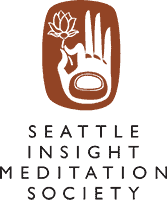See all series | See all talks
Teacher: Rodney Smith
Date: 2016-08-16
Venue: Seattle Insight Meditation Center
Series
- Continua of Practice 2015-05-12
Description
The question is not whether we suffer, everyone struggles, but whether we have struggled enough. Like a football player who endures the concussions and bodily pains in order to reap the praise and exhilaration of team sports, we can overstay our struggles for many reasons. Some of us may feel deserving of our pain and reluctant to release its causes and conditions. We might feel a nobility and pride that we have endured whatever life brings our way, or we may believe that we need to suffer almost as a recompense for our years of guilt. There is a dharma maturity necessary to call an end to our suffering and to step out of the closed loop of its perpetuation. The beginning of dharma practice is coming to that conclusion and witnessing how our struggles are an internal response to objective conditions. The external difficulties will come and go with each turn of events but our internal response can always be independent of those conditions. Understanding this is the beginning of the Buddha’s path.
This lesson is often learned gradually. We access this critical point through our internal conversation, our personal narrative. It is here, within our storyline that the machine of self works its continuance. What are we saying, what are we believing, what assumptions are we making, and what are we projecting onto the innocent to avoid our own responsibility? It is all contained within our thinking, and nothing in meditation works in alignment with its intended purpose until we are fully accountable for our thoughts. The twisted logic on which these thoughts are based often reside within our painful memories and stories of our early years of development. As we learn to hold and release daily thoughts, emotions, and memories, we also learn to forgive and let go of our distant past. We slowly become more current and begin to see that it is the present that contains the past. There is no past outside the present, and if we can live emphasizing the present, we can learn to release the past as it is arising.
Now suffering takes on a more nuanced look. As the egoic density lightens, new expressions of contention arise. We begin to sense that we live in a slightly contracted state most of the time. This state serves our need for a personal image and individual authority, but it begins to grate upon our heart, which yearns for wider pastures without boundaries. We become inquisitive about this newly discovered and more subtle expression of struggle and turn our attention toward it. What we witness is that life seems to be outside of us, and we are looking in at it, like we were tourists on a cruise ship through some exotic landscape. We begin to explore the life that seems to be outside and the life that is in here, and a fundamental question arises. “How many lives are there and why are they separated?” This inquiry sends us deeply into the configuration of our perceptions, the you and me, the this and that of our observations.
We walk through this inquiry between the desire to understand and the fear of what we might discover. It is our yearning hearts that keep us steady of gaze and solidly present. All we are ever asked to do is what is natural for us to do. Simply allow the natural questions of the heart to arise in curiosity while keeping our eyes open for the anwers.
Homework
Be aware of the range and expressions of your struggles. Use the week to focus on the gross and subtle forms of your personal pain as it occurs throughout the day. Each time you find yourself in conflict, ask yourself: Who is responsible for this? Watch your tendency to blame and externalize the causes.
Follow these steps the next time you find yourself blindly moving through the various tensions of your life. Stop, interrupt the behavior, and bring forth a spiritual perspective by asking:
- Am I aware of the pain that is driving this behavior?
- What am I getting out of this, and is this what I want my life to be about?
- What am I really lacking in this moment?
- Can I simply know that I am desiring without acting upon it.
If you are determined to follow through with this impulse at least slow down and learn all about this behavior and what motivates it?
Video
Link to view on Vimeo: https://vimeo.com/179263807
TalkID=510 SeriesID=61

